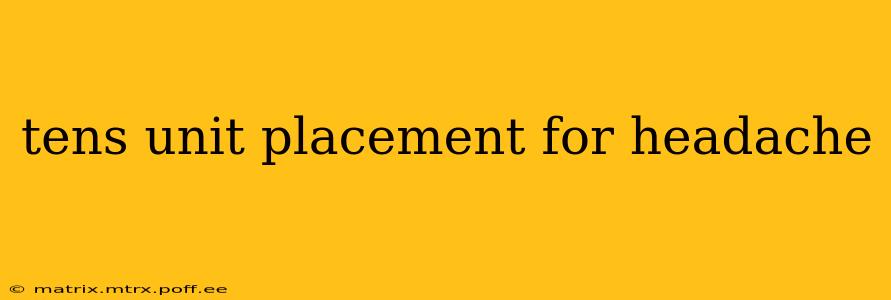Headaches are a common ailment, causing significant discomfort and impacting daily life. While many over-the-counter and prescription medications exist, some individuals seek alternative pain management methods. Transcutaneous electrical nerve stimulation (TENS) therapy offers a drug-free option for headache relief. This guide explores effective tens unit placement strategies for various headache types, addressing common questions and concerns.
How Does a TENS Unit Work for Headaches?
TENS units work by delivering small electrical impulses through electrodes placed on the skin. These impulses stimulate nerve fibers, blocking pain signals from reaching the brain. The mild electrical stimulation can also trigger the release of endorphins, the body's natural painkillers. For headaches, TENS units primarily target the nerves in the head, neck, and shoulders, areas often associated with headache pain. The exact mechanism isn't fully understood, but the effectiveness is demonstrably supported by various studies. It's crucial to remember that TENS therapy is not a cure for headaches, but rather a potential tool for pain management.
Best Tens Unit Placement for Headaches: Location Matters
Optimal tens unit placement significantly influences the effectiveness of the therapy. There isn't a single "best" placement for all headaches, as the ideal location depends on the type and location of your headache. However, some common placement strategies include:
For Tension Headaches:
Tension headaches often involve muscle tension in the neck and shoulders. Therefore, electrode placement should focus on these areas:
- Neck: Place one electrode on either side of the neck, at the base of the skull. Another option is placing one electrode on each trapezius muscle (upper back muscles).
- Shoulders: Placing electrodes on the upper trapezius muscles or near the shoulder blades can help alleviate tension in these areas. Experiment with different positions to find what provides the most relief.
For Migraines:
Migraines often involve throbbing pain on one side of the head. Placement strategies can focus on:
- Temple: Place one electrode on the temple on the affected side and the other on the opposite side of the forehead, close to the hairline.
- Nerve Points: Research suggests applying electrodes to specific nerve points, like the supraorbital nerve (above the eyebrow) or the greater occipital nerve (at the base of the skull), might provide relief. Precise placement for these points requires consultation with a healthcare professional.
For Sinus Headaches:
Sinus headaches are characterized by pain and pressure around the sinuses. Electrode placement should focus on:
- Forehead: Place electrodes on either side of the forehead, above the sinuses. Placement may also include the cheeks, close to the sinuses, though this requires careful attention to avoid irritating the skin.
- Across the Forehead: Placing one electrode on each side of the forehead, about an inch above the eyebrows, can sometimes alleviate pain.
Important Note: Always consult the instructions that come with your specific TENS unit. The device and its electrodes may have specific recommended placement guidelines.
What are the Common Side Effects of Using a TENS Unit for Headaches?
While generally safe, TENS therapy can have some minor side effects. These usually include:
- Skin irritation: Some individuals might experience mild skin redness or irritation under the electrodes. Using conductive gel and ensuring proper electrode placement can minimize this risk.
- Muscle twitching: Mild muscle twitching or spasms may occur during treatment. Adjusting the intensity can often alleviate this.
- Burning sensation: A slight burning or tingling sensation is common. If this becomes excessively uncomfortable, lower the intensity.
How Long Should You Use a TENS Unit for Headache Relief?
The duration of TENS therapy for headaches varies depending on individual response and the severity of the pain. It is advisable to start with shorter sessions (15-20 minutes) and gradually increase the duration as tolerated. It's important not to overuse the device, as this may lead to skin irritation or reduced effectiveness. Always follow the manufacturer's recommendations.
Can I Use a TENS Unit for Headaches Every Day?
While some people may use a TENS unit daily for headache management, it's important to listen to your body and avoid overuse. Daily use should ideally be part of a broader headache management strategy guided by a healthcare professional.
Is a TENS Unit Effective for All Types of Headaches?
TENS therapy has shown some efficacy for tension headaches and migraines, but its effectiveness varies among individuals. It may not be as effective for all types of headaches, such as cluster headaches. Always consult with a healthcare professional to determine if TENS is an appropriate treatment option for your specific condition.
Conclusion
TENS unit placement for headache relief involves carefully considering the type and location of the headache. While there are general guidelines, individual responses may vary. Always consult with a healthcare professional before starting TENS therapy, particularly if you have pre-existing medical conditions or are taking other medications. This guide aims to provide information and should not be considered medical advice. Remember to prioritize a comprehensive approach to headache management, combining TENS therapy with other strategies as necessary.
